A Guide to Risk Management in Construction Projects
Developed by Jokin Brito
Contents |
Abstract
Throughout history, construction has been one of the most revenue generating industries in the world and like many other businesses, is being transformed to meet the highest demands of the twenty-first century. Only in the United States, more than 11.1 million people were employed by the construction industry in 2018[1], the industry spending topped $1.23 trillion in 2017[2] and it accounted for between 7% of total U.S. GDP.[3] Furthermore, today's construction industry involves more dynamic and uncertain planning than ever before. Decision-makers and project managers require better knowledge and systematic tools, not only in project management, but also in risk management, a discipline that has a special complexity in construction projects. This article has the goal of giving project managers and decision-makers within construction industry a more detailed guide to fulfill the needs of any project they manage, where they can identify and reduce cost and time over-runs and security risks, in order to optimize the chances of project success. The guide follows the Project Management Institute (PMI) standards in the PMBOK® Guide.
Four phases can be found in project management, where the executing order is really important: scope, schedule, cost and risk. With the first three constraints defined, risk is the last but not least constraint remaining, and it is certainly the one that has no exact answer and the most abstract one. This guide could help project managers to define risks within their projects but it is a discipline that is highly dependent on the manager criteria.
Background
Structure of this article
The article structure is aligned with the standards in the PMBOK® Guide, following the same processes. First the key and basic concepts of risk management are given, where the types of risks that a project can suffer are explained. Then, the processes are analyzed giving examples and customizing them to the needs of construction industry. The goal is to give a clear guidance through the process to project managers in construction projects.
Finally, the limitations of risk management in construction projects are explained.
Construction Industry
The size of construction projects has outgrowed the industry's capacity to manage complex problems under conditions of uncertainty. Risk management in large scale projects becomes a more important part of overall construction management. Each project is very different from each other and they can't be managed in a systematic way, such as in other industries, thus risk management has always been a more trial-and-error method, which requires symbolic reasoning. Empirical knowledge plays a major role for decision-makers and project managers in every stage under uncertainty and many problems in the industry are not very well defined so the risks that this problems entail are much more difficult to define.
In this article the focus is giving a more systematic way of evaluating and defining risks on any construction project, helping project managers to base their decisions on the standars in the PMBOK® Guide and in the experience of previous projects.
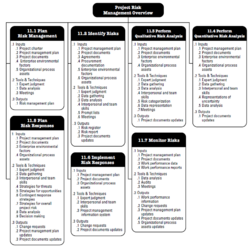
Project Risk Management
Project Risk management includes the processes of conducting risk management planning, identification, analysis, response planning, response implementation, and monitoring risk on a project. The objectives of project risk management are to increase the probability and/or impact of positive risks and to decrease the probability and/or impact of negative risks, in order to optimize the chances of project success.[5].
The Project Risk Management processes according to the PMBOK® Guide are:
- Plan Risk Management
- Identify Risks
- Perform Qualitative Risk Analysis
- Perform Quantitative Risk Analysis
- Plan Risk Responses
- Implement Risk Responses
- Monitor Risks
The goal of this article is to provide guidance on each one of this processes, applied to any construcion project.
Key Concepts
All projects have a difficulty degree and a risky level that aim to deliver benefits and achieve certain goals. Even though this barely happens in the construction industry, organizations should always choose to make decisions in a controlled manner, balancing cost and benefit. When risks of any project are not well managed, they have the potential to deviate the project from the original plan and fail to achieve the defined objectives.
In every project, risks exist at two levels:
- Individual project risk Uncertain event or condition that, if occurs, has an effect on one or more project objectives. When these risks are unmanaged, it may result in problems such as delay, cost overruns, performance shortfall or loss of reputation. Opportunities that are captured can lead to benefits in the same categories.
- Overall project risk Uncertainty of the project as a whole, representing the exposure of stakeholders to the implications of variations in project outcome, both positive and negative. A good management of these risks, aims to keep project risk exposure within an acceptable range, maximizing the probability of achieving overall project objectives.
The aim of project risk management is to ensure that all types of risk are considered and that projects risks are understood in a wider context. Trends and ememerging practices for Project Risk Management include but are not limited to:
- Non-event risk: The two types of non-event risks are variability risk, where uncertainty exists about some key characteristics of a planned event or activity or decision. And ambiguity risks, where uncertainty exists about what might happen in the future.
- Project resilience: These emergent risks are better known as unknowable-unknowns and they can be tackled through developing project resilience. This requires each project to have an specific risk budget for known risks, flexible project processes that can cope while maintaining overall direction of the project, empowered project team that is trusted to get the job done with agreed-upon limits, frequent review of early warning signs and clear input from stakeholders to clarify areas where the project scope or strategy can be adjusted in response to emergent risks.
- Integrated risk management: Projects may be part of a program or portfolio, where risks also exist and should be owned and managed at the appropiate level. Some risks can be managed by the project team or manager but some risks may escalate to a higher level. A coordinated approach to enterprise-wide risk management ensures alignment and coherence in the way risk is managed across all levels.
Each project is unique and it is necessary to tailor the way Project Risk Management processes are applied. These considerations include project size, project complexity, project importance and development approach.
Application
Plan Risk Management
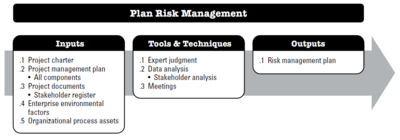
This is the process where the risk management activities are defined, ensuring that the degree, type and visibility of risk management are propotionate to both risks and the importance of the project to the organization and other stakeholders. The process is defined once or at predefined points in the project. It may be necessary to revisit this process in a major phase change or if the project scope changes significantly.[5].
Inputs, tools and techniques and outputs are predefined in this process as shown in figure 2 and they should be aligned with the project integration management process of the PMBOK® Guide. It should result on strategies and methodologies that should be followed to manage the risks, roles and responsabilities of each team member, the funding needed to perform these activities and defined risk categories. The definition of risk probability and impacts, which is usually arranged in a scale of five levels is very important, in order to understand and classify the impact that the identified risks can make on the project. The scale should include the probability of occurence, the cost of each level of probability in case of any event and the description of the impact on the project.
This task should be done mainly by the project risk manager, who will plan the strategy to follow during the next processes of the guide. The goal is to have a clear plan of what to do in the complete risk management process.
Reporting formats and tracking documents should also be elaborated to simplify how risks will be communicated.
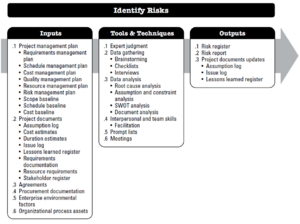
Identify Risks
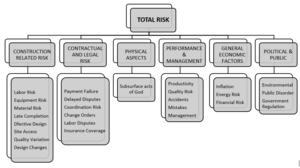
This is the process where the team should identify probable risks that could have both positive and negative impact on the project and gather them according to the risk plan previously done. This process is performed throughout the project. The inputs, tools & techniques and outputs that the team should follow are shown in Figure 3.
In this process is very important to involve the project team so they can develop and maintain a sense of ownership and responsibility for identified individual project risks, the level of overall project risk, and associated risk response actions. In construction projects, the previous experience of each member of the team is specially important in risk identification, a brainstorming meeting could be very helpful to create a list of possible threats or opportunities. Identify Risks is an iterative process, since new individual project risks may emerge as the project progresses through its life cycle and the level of overall project risk will also change.[5].
Even though, every project is different and specially construction projects have a high level of uncertainty, external resources could also be taken into account, such as academic studies, industry studies and records from the same organization. The target is to have a list of every possible risk or uncertainty factors that affect productivity, cost, time, quality and performance, so the project management could categorize them according to the risk plan. This list includes the principal risks of all major parties (contractors, designers and owners) involved in a construction project.
It is also important that if any risk happens, the team has a prepared document regarding lessons learned, so this could help in future projects and identifying potential threats and opportunities. It can also be updated with information on techniques that were effective in identifying risks to improve performance in later phases or other projects.[9].
Perform Qualitative Risk Analysis
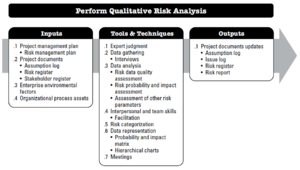
Perform Qualitative Risk Analysis is the process of prioritizing individual project risks for further analysis or action by assessing their probability of occurrence and impact as well as other characteristics. The key benefit of this process is that it focuses efforts on high-priority risks. This process is performed throughout the project. The inputs, tools and techniques, and outputs of the process are depicted in Figure 5.[5].
As previously said, construction projects have a high level of uncertainty and the expertise of the team could be very useful to develop a hierarchical chart, categorizing the previously identified risks by the probability of occurence and its impact on project objectives. Risks can be prioritized for further analysis and planning of risk responses based on their probability and impacts. Industry studies of similar projects and published material could also be used, even though it could be hard to compare external projects with an specific projects.
It is very important to include representatives from all areas influencing the project scope, schedule and cost: sponsor, development, engineering, procurement, construction, operations, legal, etc.
Perform Quantitative Risk Analysis
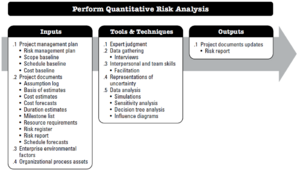
Is the process of numerically analyzing the combined effect of identified individual project risks and other sources of uncertainty on overall project objectives. The key benefit of this process is that it quantifies overall project risk exposure, and it can also provide additional quantitative risk information to support risk response planning. This process is not required for every project, but where it is used, it is performed throughout the project. The inputs and outputs of this process are depicted in Figure 6.
Perform Quantitative Risk Analysis is not required for all projects. Undertaking a robust analysis depends on the availability of high-quality data about individual project risks and other sources of uncertainty, as well as a sound underlying project baseline for scope, schedule, and cost. Quantitative risk analysis usually requires specialized risk software and expertise in the development and interpretation of risk models.[5]. Moreover, this methods are not very reliable in construction projects because of the uncertainty levels of the risks and the difficulty of quantifying the economical impact of this events.
Even though it's hard to find exact numbers from this process, it is very important to consider a budget line to mitigate the identified risks. This budget line will be defined depending on the project risk level, the higher the risk, the higher budget for this purpose. Usually in construction projects, this is a percentage of the overall budget. A budget line for the risks concerning the delivery of the final product (building or project) should also be considered, this to mitigate the cost for hidden faults that could emerge.
Plan Risk Responses
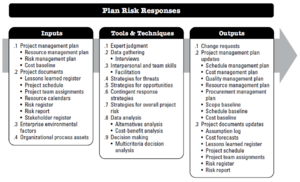
Plan Risk Responses is the process of developing options, selecting strategies, and agreeing on actions to address overall project risk exposure, as well as to treat individual project risks. The key benefit of this process is that it identifies appropriate ways to address overall project risk and individual project risks. This process also allocates resources and inserts activities into project documents and the project management plan as needed. This process is performed throughout the project. The inputs, tools and techniques, and outputs of the process are depicted in Figure 7.[5]
The expertise of the team involved in the project is again highly important for this process, the target is to propose specific advice to minimize risks and their economic consequences. The process in construction projects are more complex than in most other domains because of the fact that uncertainty factors are expressed in natural language with jargon.[9] Again the complexity of this process in construction projects is due to the difficulty to quantify the consequences of any threat or benefit, but a contingency plan should be developed for major risks. The project manager and the team should know exactly what to do in case of any event, even though the economic impact remains unknown.

Implement Risk Responses
This process consits in implementing agreed-upon risk response plans. The key benefit of this process is that it ensures that agreed-upon risk responses are executed as planned in order to address overall project risk exposure, minimize individual project threats, and maximize individual project opportunities. The inputs, tools and techniques, and outputs of the process are shown in Figure 8.[5]
This is the process where the planning is implemented and decision-makers and project managers need to know what to do in case of a contingency, and the impact that the previously identified risk could have. For example, consider the case where a contractor delays due to bad weather or even negligence, what actions should be taken? These actions should be aligned with the risk management plan and with the consequences previously identified, with the respective costs that this events may entail. The project manager needs to have very clear the cost of every contingency and the cost of the action that needs to be taken on the overall result of the project. For example, in the case of a delay in the program, the project manager needs to know the cost of each day of delay and what actions are allowed to be taken.
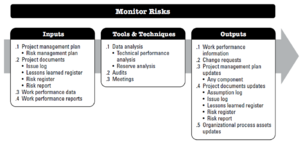
Monitor Risk
Monitor Risks is the process of monitoring the implementation of agreed-upon risk response plans, tracking identified risks, identifying and analyzing new risks, and evaluating risk process effectiveness throughout the project. The key benefit of this process is that it enables project decisions to be based on current information about overall project risk exposure and individual project risks. The inputs, tools and techniques, and outputs of the process are depicted in Figure 9.[5]
The target is to use performance information during the project execution to determine if the followed strategy is the right one, if the risk management approach is still appropiate or if contingency reserves for cost or schedule require modification. It is essential for the project manager to know if the action taken after a risk occured, has been the right one and has reduced cost and time over-runs, maybe the action taken was even worst than the problem and a rethinking on the strategy has to be done.
It is also important to identify new risks or new threats that could have a negative impact on the project, or potential opportunities that eventually could benefit the overall project results.
Limitations
The Project Management Institute (PMI) standards in the PMBOK® Guide, establishes a detailed guide to manage the risks in every project. Risk management is the most uncertain discipline in project management and this makes harder to follow the guide to the detail. Even though, risk management is highly important in every project, project managers in construction industry are more likely to follow empirical methods to mitigate these risks. The porpose of this guide is to give an easy to follow method to decision makers and project managers.
However, following a defined process is hard for construction projects because every project is very different and "unknowable unkowns" are more frequent in this type of projects than in projects from industries with defined processes. This makes harder to follow the guide and this is one of the reasons why construction project managers tend to follow more empirical methods.
Annotated Bibliography
A guide to the project management body of knowledge. (2017). 6th ed. Newtown Square, Pennsylvania, USA: Project Management Institute, pp.395-458 The book contains the last version of the PMBOK® Guide, the article is based on the process established by this book.
Kangari, R. (1988). Construction Risk Management. Civ. Engng Syst., Vol. 5, p.114-120. The article contains advisory on managing risks on construction projects.
References
- ↑ Bls.gov. (2019). Employed persons by detailed industry, sex, race, and Hispanic or Latino ethnicity. [online] Available at: https://www.bls.gov/cps/cpsaat18.htm [Accessed 17 Feb. 2019].
- ↑ Construction spending in the United States from 1996 to 2017, s. (2019). U.S. construction spending: public and private sectors 2017 | Statistic. [online] Statista. Available at: https://www.statista.com/statistics/226355/us-public-and-private-sector-construction/ [Accessed 17 Feb. 2019].
- ↑ 2018 FMI Overview, Featuring FMI’s Fourth Quarter 2017 Construction Outlook. (2018). [online] Available at: https://www.fminet.com/wp-content/uploads/2018/01/Overview2018_FINAL-1.pdf [Accessed 17 Feb. 2019].
- ↑ A guide to the project management body of knowledge. (2017). 6th ed. Newtown Square, Pennsylvania, USA: Project Management Institute, pp.396
- ↑ 5.0 5.1 5.2 5.3 5.4 5.5 5.6 5.7 A guide to the project management body of knowledge. (2017). 6th ed. Newtown Square, Pennsylvania, USA: Project Management Institute, pp.395-458
- ↑ A guide to the project management body of knowledge. (2017). 6th ed. Newtown Square, Pennsylvania, USA: Project Management Institute, pp.401
- ↑ A guide to the project management body of knowledge. (2017). 6th ed. Newtown Square, Pennsylvania, USA: Project Management Institute, pp.409
- ↑ Kangari, R. (1988). Construction Risk Management. Civ. Engng Syst., Vol. 5, p.116.
- ↑ 9.0 9.1 Kangari, R. (1988). Construction Risk Management. Civ. Engng Syst., Vol. 5, p.114-120.
- ↑ A guide to the project management body of knowledge. (2017). 6th ed. Newtown Square, Pennsylvania, USA: Project Management Institute, pp.419
- ↑ A guide to the project management body of knowledge. (2017). 6th ed. Newtown Square, Pennsylvania, USA: Project Management Institute, pp.428
- ↑ A guide to the project management body of knowledge. (2017). 6th ed. Newtown Square, Pennsylvania, USA: Project Management Institute, pp.437
- ↑ A guide to the project management body of knowledge. (2017). 6th ed. Newtown Square, Pennsylvania, USA: Project Management Institute, pp.449
- ↑ A guide to the project management body of knowledge. (2017). 6th ed. Newtown Square, Pennsylvania, USA: Project Management Institute, pp.453